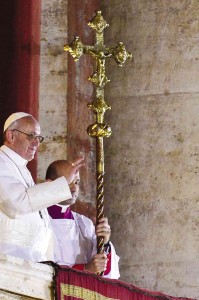
‘BROTHERS AND SISTERS, GOOD EVENING’ These are the first words of Pope Francis, formerly Cardinal Jorge Mario Bergoglio of Buenos Aires, Argentina, as he greets an estimated crowd of 100,000 Catholic faithful in St. Peter’s Square in the Vatican shortly after he was elected the 266th head of the Catholic Church. He is a Pope of many firsts: The first from the New World, the first Jesuit, the first to choose the name Francis and the first non-European since the Middle Ages. AFP
MANILA, Philippines—Why not Benedict XVII? John Paul III? Paul VII? Pius XIII? Or even Peter II?
Argentine Jorge Maria Cardinal Bergoglio has been rightfully called a pontiff of many “firsts,” but the groundbreaking nature of his unexpected rise to the papacy perhaps begins with his choice of papal name: Francis.
In his 2012 book “Pope Names,” church scholar Jimmy Akin gave a rather generous “one-percent” chance that the next supreme pontiff after Pope Benedict XVI would pick a “new unprecedented name.”
Akin, whose original work tracked and analyzed all the names used by the Catholic Church’s 265 popes (including the “anti-popes”) since the time of Peter, believed that the odds were “actually lower than 0.8 percent.”
That’s based on the fact that since AD 996, when the practice of taking papal names became common, only Albino Luciani did the “unprecedented” and took the name John Paul for what would be a short-lived, 33-day papacy in 1978. It was unexpected, Akin explained, because Luciani combined the names of two previous pontiffs, Pope John XXIII (who began the work for the Second Vatican Council) and Paul VI (under whose watch the council was completed).
“I don’t want to list the chances as zero, so I’m giving this a 1 percent chance, just to anticipate the unexpected,” Akin wrote on the chances that Benedict’s successor would choose an entirely different name.
And Bergoglio did just that, picking “Francis,” which was hitherto unused by pontiffs as an assumed name.
The new pope has explained his name choice. It’s after Francis of Assisi, founder of the mendicant Franciscan order, not Francis Xavier, a co-founder of the Society of Jesus (Jesuits) to which Bergoglio belongs.
It’s the names he could have picked—but did not—that probably invite more curiosity.
Like most of his predecessors, Bergoglio understandably steered clear of Peter, who is considered the first Pope, for that would naturally raise eyebrows. Based on Catholic belief, Jesus himself gave the name “Peter” (from the Aramaic “Kepha” meaning “rock”) to his top apostle Simon bar-Jona, the first pope’s original name.
Akin noted that one pope, who was baptized “Pietro,” had to change his name to John XIV in AD 983 “because he didn’t want to invite comparisons, as pope, to the original St. Peter.” Eleven more Peters assumed new names when they became pope.
“No pope wants to start off his reign with the massive, incredulous, ‘Who does this guy think he is? He just put his name above all his predecessors but the first!’ reaction that would follow,” Akin explained.
So why not Benedict XVII or John Paul III, Bergoglio’s two immediate predecessors?
Noting that half of the popes picked the names of one of the 10 previous pontiffs, Akin said a natural choice would be any name among Benedict XVII, John Paul III, Paul VII, John XXIV, Pius XIII or Leo XIV.
Akin said Benedict XVII was unlikely unless the outgoing pontiff died in a “crisis situation” or the successor “feels particularly indebted to him.”
The author said John Paul III was more likely, but warned that the new Pope might be “uncomfortable inviting comparisons” with someone like John Paul II, the first pope in centuries who might go down in history as “Pope St. John Paul the Great.”
And so Pope Francis it is.